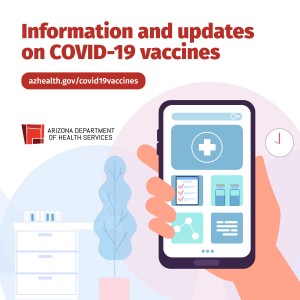 Since mid-December, when the first Pfizer vaccines reached Arizona, ADHS has been working with our local county health departments and tribes to get the COVID-19 vaccine distributed to vulnerable Arizonans as quickly as possible. To further this goal, Arizona recently adopted a hybrid model prioritizing those at highest risk due to age and our frontline essential workers. This model allows for a statewide prioritization based on age and allows our Local Allocators to provide additional sub-prioritization recommendations to ensure a fair and equitable distribution of our limited vaccine supplies in communities across the state.
Since mid-December, when the first Pfizer vaccines reached Arizona, ADHS has been working with our local county health departments and tribes to get the COVID-19 vaccine distributed to vulnerable Arizonans as quickly as possible. To further this goal, Arizona recently adopted a hybrid model prioritizing those at highest risk due to age and our frontline essential workers. This model allows for a statewide prioritization based on age and allows our Local Allocators to provide additional sub-prioritization recommendations to ensure a fair and equitable distribution of our limited vaccine supplies in communities across the state.
With limited vaccine resources, the Department relies on the Vaccine and Antiviral Prioritization Advisory Committee (VAPAC) to make recommendations for the allocation of scarce resources. A recent review of the data shows the majority of all Arizonans with chronic medical conditions would be vaccinated more rapidly, and protect those most at risk from severe COVID-19 outcomes, such as hospitalization and death, by using an age-based prioritization instead of the previous prioritization framework.
Based on this data and the feedback from committee members, VAPAC made the recommendation to move to a hybrid prioritization model. By including those 55 and above, we estimate that 55-65% of all Arizonans with a chronic medical condition placing them at severe risk for COVID-19 are immediately eligible for vaccination. When we move to 45 and older, the eligible population increases to include 70-80% of all Arizonans with a chronic medical condition. We anticipate moving to 45 and above by the end of March. When those 35 years and older are included, we estimate almost 90% of all Arizonans with a chronic medical condition placing them at severe risk for COVID-19 will be eligible. We anticipate every Arizonan over the age of 16 being eligible for vaccination by May 1st.
Under the previous prioritization, those with certain chronic medical conditions were not eligible until 1C. However, many individuals with certain chronic medical conditions would not have been eligible for vaccination until phase 2, when they would be vaccinated with the general population. Because Arizona was still in prioritized phase 1B, it would have been weeks to months before Arizona moved into phases 1C and 2 and able to vaccinate those with chronic medical conditions.
ADHS and our local health departments have been working closely with vulnerable populations to provide vaccine to high-risk groups. Early on the planning phases, Arizona worked to prioritize those most at risk in our long term care facilities and had the highest number of facilities register to participate in the CDC’s Long term Care Pharmacy Partnership Program. This program worked with registered facilities statewide to provide onsite vaccinations to staff and residents during phase 1A. Arizona was one of the only states that opened this program up to our group homes and long term care facilities for individuals with developmental disabilities. This allowed us to protect those living in congregate care settings, many of which have chronic medical conditions that put them at risk for hospitalization and death from COVID-19. Our local health departments have been working to vaccinate staff and residents in those facilities that did not sign up for the CDC LTC Pharmacy Partnership Program.
At this time, the majority of counties are vaccinating or transitioning to vaccinate those over the age of 55. You can view each county’s vaccination phase status at vaccine-phases.pdf (azdhs.gov). You can find the locations of various vaccination sites by visiting our Find Vaccine webpage at azhealth.gov/findvaccine. We are continuously updating this information as we receive it from our Local Allocators. You can find more information on the state’s COVID-19 response activities by visiting azhealth.gov/covid19.









